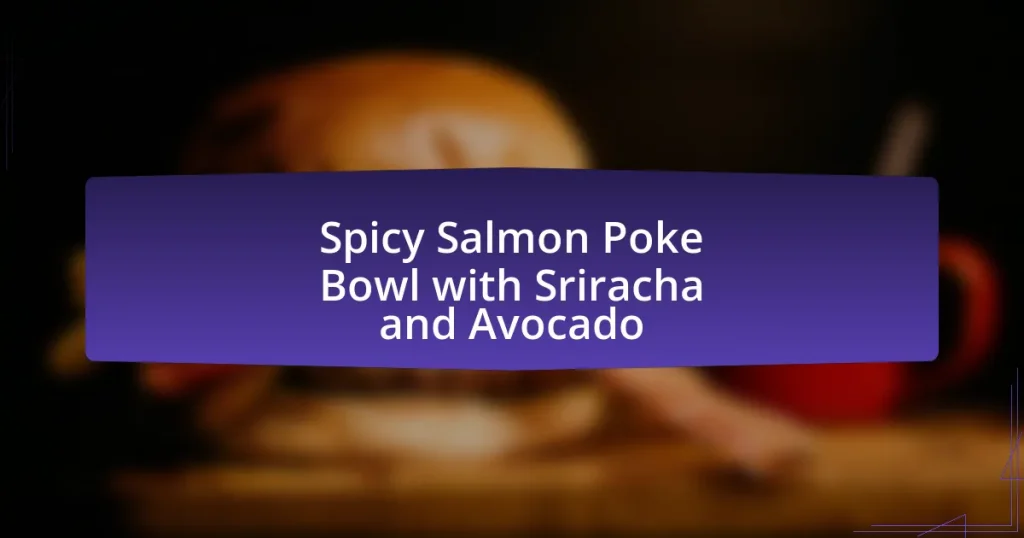Classic Ahi Tuna Poke Bowls are traditional Hawaiian dishes featuring diced raw Ahi tuna marinated in soy sauce, sesame oil, and various seasonings, served over rice with fresh accompaniments. The article explores the origins of poke bowls, their cultural influences, and the evolution of their preparation, highlighting key ingredients and health benefits. It also discusses popular variations, flavor profiles, and creative twists, along with tips for customizing and preparing poke bowls at home. Additionally, the article emphasizes the importance of ingredient quality, presentation, and beverage pairings to enhance the overall dining experience.

What are Classic Ahi Tuna Poke Bowls?
Classic Ahi Tuna Poke Bowls are traditional Hawaiian dishes that feature diced raw Ahi tuna as the primary ingredient, typically marinated in a mixture of soy sauce, sesame oil, and other seasonings. These bowls often include a base of rice, topped with various accompaniments such as seaweed, avocado, and green onions, reflecting the dish’s fresh and vibrant flavors. The use of Ahi tuna, known for its rich taste and firm texture, is essential to the poke bowl’s authenticity and popularity in Hawaiian cuisine.
How did Ahi Tuna Poke Bowls originate?
Ahi Tuna Poke Bowls originated in Hawaii, where they were traditionally made by fishermen using fresh, cubed raw tuna, known as “ahi.” This dish evolved from the practice of seasoning the fish with simple ingredients like soy sauce, sesame oil, and green onions, reflecting the local culture and available resources. The popularity of poke has grown significantly beyond Hawaii, becoming a staple in various culinary scenes worldwide, particularly in the mainland United States, where it is often customized with diverse toppings and sauces.
What cultural influences shaped the traditional poke bowl?
The traditional poke bowl is primarily shaped by Hawaiian culture, which emphasizes fresh, local ingredients and communal eating. The dish originated in Hawaii, where fishermen would season and eat raw fish, particularly ahi tuna, as a quick meal. This practice reflects the influence of Polynesian culinary traditions, which prioritize seafood and natural flavors. Additionally, Japanese cuisine has significantly impacted poke, introducing elements such as soy sauce and sesame oil, which enhance the dish’s flavor profile. The combination of these cultural influences has led to the modern poke bowl’s diverse variations, incorporating ingredients from various culinary traditions while maintaining its Hawaiian roots.
How has the preparation of poke bowls evolved over time?
The preparation of poke bowls has evolved from a traditional Hawaiian dish primarily featuring raw fish, particularly ahi tuna, to a diverse culinary experience incorporating various ingredients and flavors. Initially, poke was simply seasoned with sea salt, seaweed, and sometimes onions, reflecting local fishing practices and available resources. Over time, the dish has adapted to global influences, leading to the inclusion of ingredients such as avocado, mango, and a variety of sauces like spicy mayo and soy sauce. This evolution is evidenced by the rise of poke bowl restaurants worldwide, which offer customizable options that cater to different dietary preferences and tastes, showcasing the dish’s transition from a regional specialty to an international phenomenon.
What are the key ingredients in a Classic Ahi Tuna Poke Bowl?
The key ingredients in a Classic Ahi Tuna Poke Bowl include fresh Ahi tuna, soy sauce, sesame oil, green onions, and rice. Ahi tuna serves as the primary protein, providing a rich flavor and texture. Soy sauce adds umami, while sesame oil contributes a nutty aroma. Green onions offer a fresh, crisp element, and rice serves as the base, typically sushi rice, which is seasoned to enhance the overall dish. These ingredients are essential for achieving the traditional taste and presentation of a Classic Ahi Tuna Poke Bowl.
What types of tuna are commonly used in poke bowls?
The types of tuna commonly used in poke bowls are Ahi tuna, which includes both Yellowfin and Bigeye tuna. Ahi tuna is favored for its rich flavor and firm texture, making it ideal for raw preparations. Yellowfin tuna is known for its mild taste and vibrant color, while Bigeye tuna has a higher fat content, providing a buttery texture. These characteristics make both types of tuna popular choices in traditional poke bowl recipes.
How do different ingredients affect the flavor profile of the dish?
Different ingredients significantly influence the flavor profile of a dish, such as a Classic Ahi Tuna Poke Bowl. For instance, the use of fresh ahi tuna provides a rich, buttery flavor that serves as the dish’s foundation. Complementary ingredients like soy sauce introduce umami, enhancing the overall taste experience. Additionally, toppings such as avocado add creaminess, while ingredients like sesame oil contribute nuttiness. The inclusion of fresh vegetables, such as cucumber and radish, adds crunch and freshness, balancing the richness of the tuna. Each ingredient’s unique flavor compounds interact, creating a harmonious blend that defines the poke bowl’s character.
What are the health benefits of Ahi Tuna Poke Bowls?
Ahi Tuna Poke Bowls offer numerous health benefits, primarily due to their high protein content and rich supply of omega-3 fatty acids. Ahi tuna is an excellent source of lean protein, providing about 25 grams of protein per 3-ounce serving, which supports muscle growth and repair. Additionally, the omega-3 fatty acids found in Ahi tuna, such as EPA and DHA, are known to promote heart health by reducing inflammation and lowering triglyceride levels. Studies indicate that regular consumption of omega-3s can decrease the risk of cardiovascular diseases. Furthermore, Ahi tuna is low in calories and contains essential vitamins and minerals, including vitamin D and selenium, which contribute to overall health and immune function.
How does Ahi tuna contribute to a balanced diet?
Ahi tuna contributes to a balanced diet by providing high-quality protein, essential omega-3 fatty acids, and important vitamins and minerals. This fish is rich in protein, with approximately 25 grams per 100 grams serving, which supports muscle growth and repair. Additionally, Ahi tuna contains omega-3 fatty acids, which are known to promote heart health and reduce inflammation. It also offers vital nutrients such as vitamin D and selenium, which are important for bone health and immune function, respectively. The combination of these nutrients makes Ahi tuna a valuable component of a balanced diet.
What nutritional values are associated with the ingredients in poke bowls?
Poke bowls typically contain ingredients such as raw fish, rice, vegetables, and various toppings, each contributing distinct nutritional values. For instance, ahi tuna, a common base, is rich in protein, providing approximately 25 grams per 3-ounce serving, and is a source of omega-3 fatty acids, which are beneficial for heart health. The rice, often sushi or brown rice, contributes carbohydrates, with about 45 grams per cup, and provides energy. Vegetables like seaweed and avocado add fiber, vitamins, and healthy fats; seaweed is particularly high in iodine and antioxidants, while avocado offers monounsaturated fats and potassium. Toppings such as sesame seeds and soy sauce can enhance flavor but may add sodium, with soy sauce containing around 900 mg of sodium per tablespoon. Overall, the combination of these ingredients results in a balanced meal rich in protein, healthy fats, and essential nutrients.

What are the popular variations of Classic Ahi Tuna Poke Bowls?
Popular variations of Classic Ahi Tuna Poke Bowls include Spicy Ahi Poke, which incorporates spicy mayo or Sriracha for heat, and Shoyu Ahi Poke, featuring a soy sauce-based marinade. Other variations are the Hawaiian-style poke, which often includes ingredients like seaweed and sesame oil, and the Mango Ahi Poke, which adds fresh mango for sweetness. These variations reflect regional preferences and ingredient availability, enhancing the traditional poke bowl experience.
How do regional variations influence poke bowl recipes?
Regional variations significantly influence poke bowl recipes by incorporating local ingredients and culinary traditions. For instance, in Hawaii, traditional poke bowls often feature fresh ahi tuna, soy sauce, and sesame oil, reflecting the islands’ access to fresh seafood and Asian culinary influences. Conversely, in mainland U.S. regions, poke bowls may include ingredients like avocado, spicy mayo, or even quinoa, showcasing a fusion of health trends and local tastes. This adaptability allows poke bowls to resonate with diverse palates while maintaining their core essence, demonstrating the dish’s evolution across different cultures and regions.
What are some common toppings used in different poke bowl styles?
Common toppings used in different poke bowl styles include avocado, seaweed salad, pickled ginger, and sesame seeds. These toppings enhance the flavor and texture of the poke bowl, providing a balance of creaminess, umami, and crunch. For instance, avocado adds a rich, creamy element, while seaweed salad contributes a savory taste and nutritional benefits. Pickled ginger offers a tangy contrast, and sesame seeds provide a nutty flavor and visual appeal. Each topping complements the base ingredients, such as ahi tuna, and reflects regional variations in poke bowl preparation.
How do flavor profiles differ between traditional and modern variations?
Traditional flavor profiles of Ahi Tuna Poke Bowls emphasize simplicity and freshness, often featuring soy sauce, sesame oil, and green onions, which highlight the natural taste of the tuna. In contrast, modern variations incorporate diverse ingredients such as avocado, spicy mayo, and various toppings like seaweed salad or pickled vegetables, creating a more complex and layered flavor experience. This shift reflects a broader culinary trend towards fusion and personalization, allowing for a wider range of tastes and textures in contemporary poke bowls.
What are some creative twists on the Classic Ahi Tuna Poke Bowl?
Creative twists on the Classic Ahi Tuna Poke Bowl include incorporating unique ingredients such as mango for sweetness, avocado for creaminess, and spicy mayo for heat. These variations enhance the traditional flavors while adding new textures and tastes. For example, a tropical poke bowl might feature diced mango and coconut flakes, while a spicy version could include jalapeños and sriracha. Additionally, using quinoa instead of rice introduces a nutritious element, and adding pickled vegetables can provide a tangy contrast. These adaptations not only diversify the flavor profile but also cater to different dietary preferences and trends.
How can different sauces enhance the poke bowl experience?
Different sauces can significantly enhance the poke bowl experience by adding layers of flavor, texture, and complexity. For instance, soy sauce provides umami, while spicy mayo introduces creaminess and heat, creating a balanced taste profile. Additionally, ponzu sauce adds a citrusy brightness that complements the freshness of the fish. According to a study published in the Journal of Culinary Science & Technology, the incorporation of diverse sauces can elevate the sensory experience of dishes by engaging multiple taste receptors, thus making the poke bowl more enjoyable.
What unique ingredients can be added for a gourmet touch?
Unique ingredients that can be added for a gourmet touch to a Classic Ahi Tuna Poke Bowl include truffle oil, yuzu citrus, and pickled ginger. Truffle oil enhances the dish with an earthy aroma and rich flavor, while yuzu adds a bright, citrusy note that elevates the overall taste profile. Pickled ginger provides a tangy contrast that complements the freshness of the tuna. These ingredients are often used in high-end culinary settings to create a refined dining experience, showcasing the versatility and sophistication of poke bowls.
What are the most popular poke bowl combinations?
The most popular poke bowl combinations typically include Ahi tuna, avocado, seaweed salad, and sesame seeds. These ingredients are favored for their complementary flavors and textures, creating a balanced dish. Ahi tuna serves as the primary protein, while avocado adds creaminess, seaweed salad contributes umami, and sesame seeds provide a crunchy finish. Other common additions are cucumber, radish, and various sauces like soy sauce or spicy mayo, enhancing the overall taste profile.
Which ingredient pairings are favored by chefs and home cooks alike?
Chefs and home cooks alike favor ingredient pairings such as soy sauce and sesame oil, avocado and cucumber, and scallions and seaweed in their dishes. These combinations enhance flavor profiles and provide a balance of textures, which is particularly important in dishes like Ahi Tuna Poke Bowls. For instance, soy sauce adds umami, while sesame oil contributes nuttiness, making them a staple in many Asian-inspired recipes. Similarly, the creaminess of avocado complements the crunch of cucumber, creating a refreshing contrast. Scallions and seaweed add aromatic and savory notes, further enriching the overall taste experience.
How do seasonal ingredients play a role in poke bowl variations?
Seasonal ingredients significantly influence poke bowl variations by enhancing flavor profiles and ensuring freshness. For instance, using locally sourced vegetables and fruits that are in season, such as avocados in spring or pumpkins in fall, allows for a more vibrant and diverse taste experience. This practice not only supports local agriculture but also aligns with culinary trends that prioritize sustainability and seasonal eating. Research indicates that seasonal produce often contains higher nutrient levels and better flavor, which can elevate the overall quality of the poke bowl.

How can you create your own Classic Ahi Tuna Poke Bowl variations?
To create your own Classic Ahi Tuna Poke Bowl variations, start by selecting a base, such as sushi rice, quinoa, or mixed greens. Next, choose fresh Ahi tuna, which can be marinated in soy sauce, sesame oil, or citrus juices for added flavor. Incorporate a variety of toppings like avocado, seaweed salad, cucumber, radishes, or pickled ginger to enhance texture and taste. Finally, finish with garnishes such as sesame seeds, green onions, or spicy mayo to personalize your bowl. This approach allows for endless customization while maintaining the essence of a traditional poke bowl.
What steps should you follow to prepare a Classic Ahi Tuna Poke Bowl at home?
To prepare a Classic Ahi Tuna Poke Bowl at home, start by gathering fresh sushi-grade ahi tuna, which is essential for quality. Next, dice the tuna into bite-sized cubes and place it in a bowl. Then, add soy sauce, sesame oil, and chopped green onions to the tuna, mixing gently to combine the flavors. After that, prepare a base of sushi rice, which should be cooked and seasoned with rice vinegar, sugar, and salt. Once the rice is ready, place it in a bowl and top it with the marinated tuna. Finally, garnish the poke bowl with toppings such as avocado, seaweed salad, and sesame seeds for added texture and flavor.
What tools and equipment are essential for making poke bowls?
Essential tools and equipment for making poke bowls include a sharp knife, cutting board, mixing bowls, and a rice cooker. A sharp knife is crucial for accurately slicing fresh fish and vegetables, while a cutting board provides a stable surface for preparation. Mixing bowls are necessary for combining ingredients and marinating fish, and a rice cooker ensures perfectly cooked rice, which is a fundamental component of poke bowls. These tools facilitate the preparation process and contribute to the overall quality of the dish.
How can you ensure the freshness and quality of the tuna?
To ensure the freshness and quality of tuna, purchase it from reputable sources that provide information on its catch date and handling practices. Fresh tuna should have a bright color, a clean ocean smell, and a firm texture. According to the FDA, tuna should be kept at temperatures below 40°F (4°C) to prevent spoilage. Additionally, consuming tuna within 24 hours of purchase maximizes its freshness and quality.
What tips can help you customize your poke bowl to your taste?
To customize your poke bowl to your taste, start by selecting a base that suits your preference, such as sushi rice, brown rice, or mixed greens. Next, choose your protein, with options like ahi tuna, salmon, or tofu, allowing for dietary flexibility. Incorporate a variety of toppings, including vegetables like avocado, cucumber, and seaweed, to enhance flavor and texture. Additionally, select sauces that complement your ingredients, such as soy sauce, spicy mayo, or ponzu, to add depth to the dish. Finally, consider garnishes like sesame seeds or green onions for an extra layer of flavor. These choices enable you to create a poke bowl that aligns with your personal taste preferences.
How can you balance flavors and textures in your poke bowl?
To balance flavors and textures in your poke bowl, incorporate a variety of ingredients that provide contrasting tastes and mouthfeels. For instance, use fresh ahi tuna for a rich, buttery flavor, paired with crunchy vegetables like cucumber and radish for texture. Adding creamy avocado enhances the mouthfeel, while a tangy dressing, such as soy sauce or ponzu, introduces acidity that brightens the dish. This combination of rich, crunchy, creamy, and tangy elements creates a harmonious balance, ensuring that each bite offers a diverse sensory experience.
What common mistakes should you avoid when making poke bowls?
Common mistakes to avoid when making poke bowls include using low-quality fish, neglecting to marinate the fish properly, and overcrowding the bowl with ingredients. Low-quality fish can lead to an unpleasant taste and texture, as fresh, sushi-grade fish is essential for authentic poke. Proper marination enhances flavor; skipping this step can result in bland dishes. Overcrowding can overwhelm the palate, making it difficult to appreciate individual flavors. Each component should complement the others without overpowering them, ensuring a balanced and enjoyable poke bowl experience.
What are some best practices for serving and enjoying poke bowls?
Best practices for serving and enjoying poke bowls include using fresh, high-quality ingredients, serving the bowl chilled, and allowing for customization. Fresh ingredients, such as sushi-grade fish and seasonal vegetables, enhance flavor and safety. Serving the poke bowl chilled maintains the freshness of the fish and other components, which is crucial for taste and food safety. Additionally, allowing diners to customize their bowls with various toppings, sauces, and bases caters to individual preferences and enhances the overall experience. These practices ensure a delicious and enjoyable poke bowl experience.
How can presentation enhance the dining experience of a poke bowl?
Presentation can significantly enhance the dining experience of a poke bowl by making it visually appealing and stimulating the appetite. A well-presented poke bowl, with vibrant colors from fresh ingredients like ahi tuna, avocado, and vegetables, creates an inviting aesthetic that can elevate the overall enjoyment of the meal. Research indicates that visual appeal can influence taste perception; for instance, a study published in the journal “Appetite” found that food presentation affects diners’ expectations and satisfaction levels. Therefore, an artfully arranged poke bowl not only attracts attention but also enhances the perceived quality and flavor of the dish, leading to a more enjoyable dining experience.
What are the ideal pairings for beverages with poke bowls?
The ideal pairings for beverages with poke bowls include light and refreshing options such as sake, green tea, and sparkling water. Sake complements the umami flavors of the fish, while green tea offers a subtle bitterness that balances the dish’s richness. Sparkling water enhances the overall dining experience with its effervescence, cleansing the palate between bites. These pairings are widely recognized for their ability to enhance the flavors of poke bowls, making them popular choices among diners.



